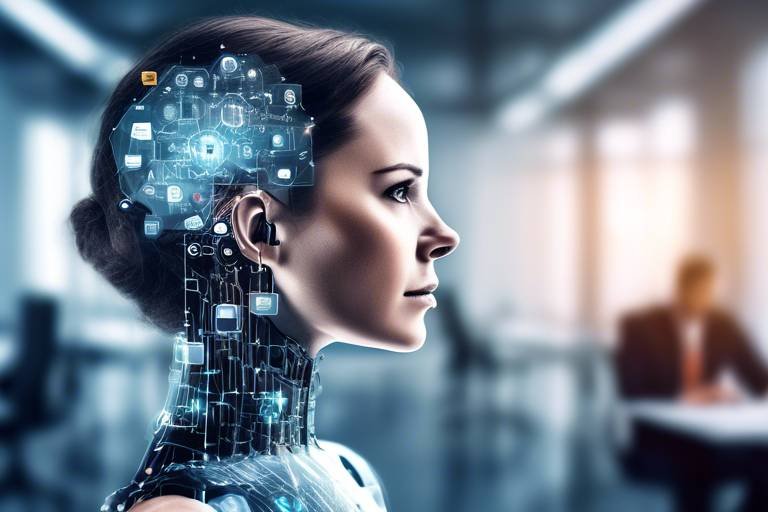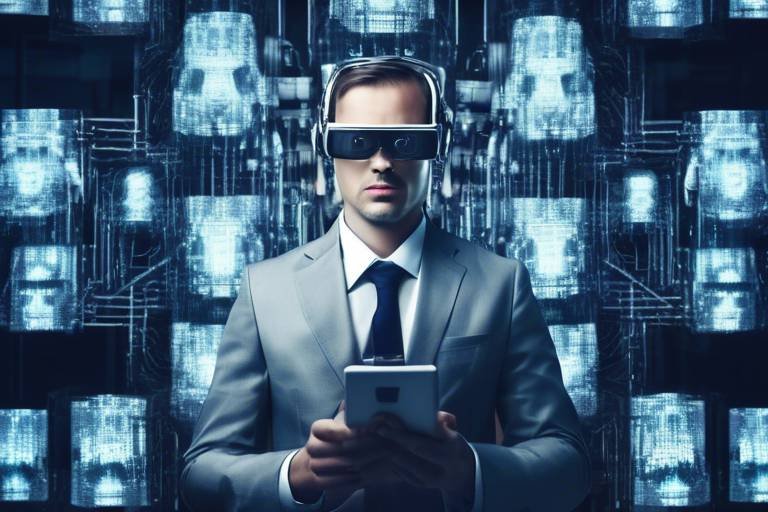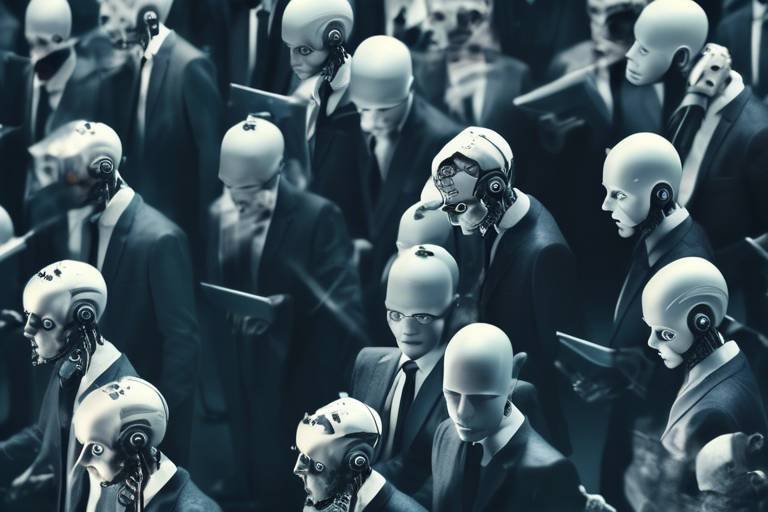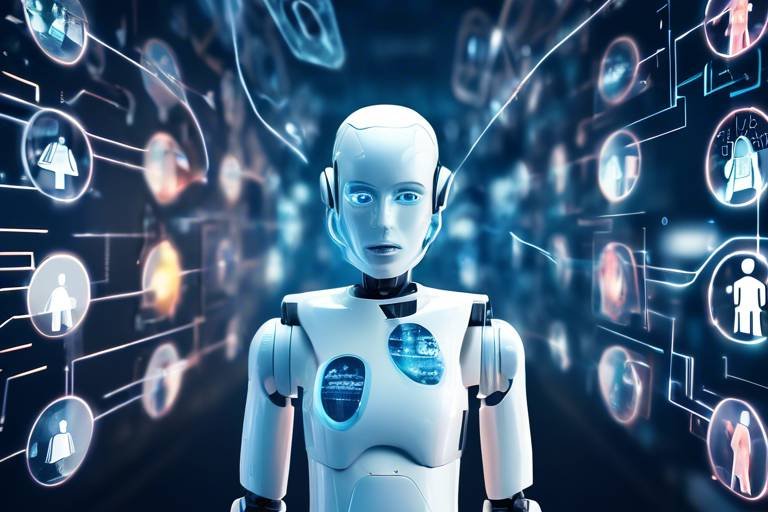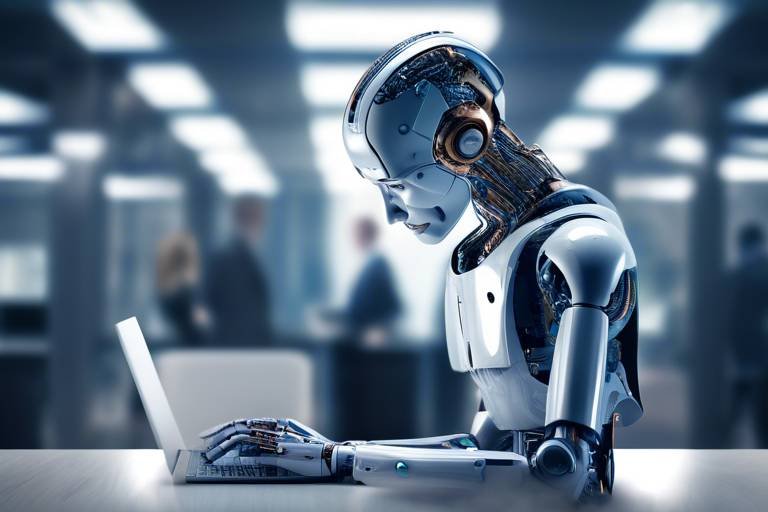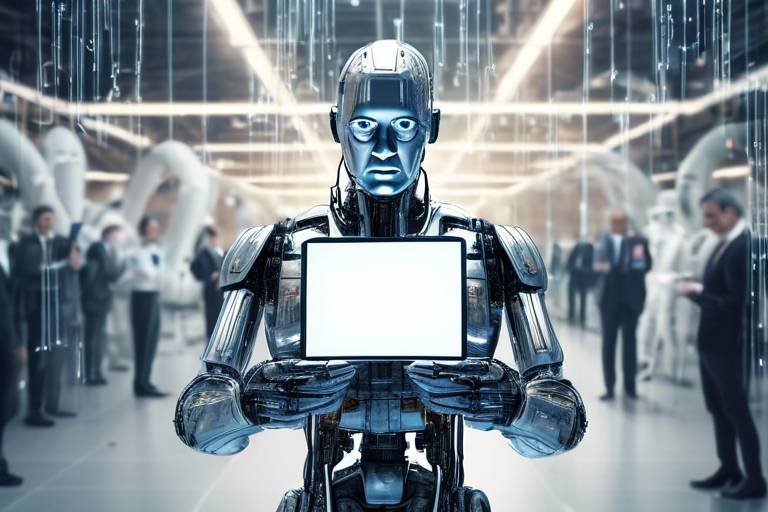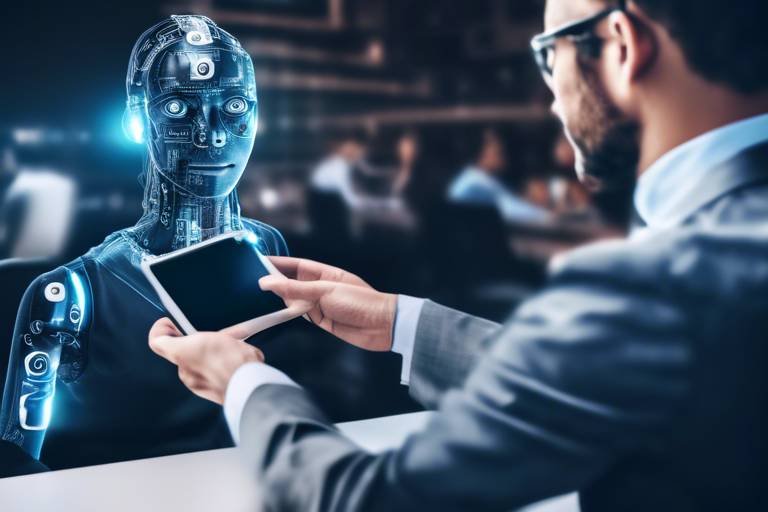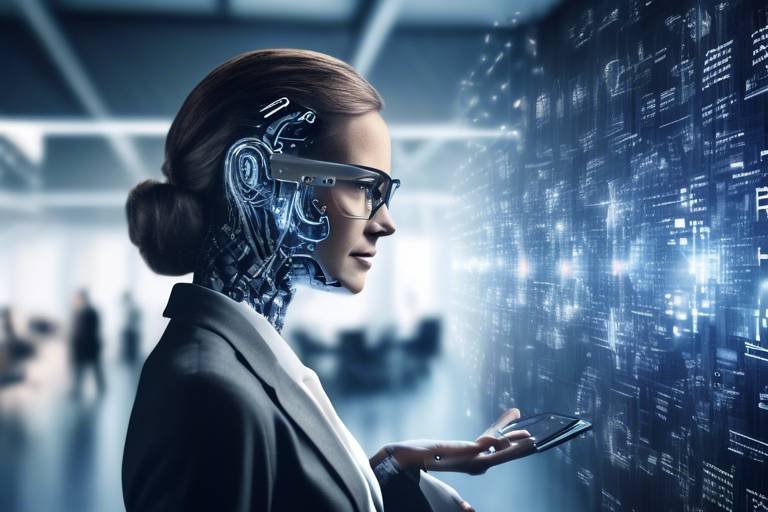AI and the Expected Enhancements in Future Job Conditions
Artificial intelligence (AI) is not just a buzzword anymore; it’s rapidly becoming a cornerstone of modern workplaces. As we step into a future where AI technologies continue to evolve, we can expect a transformative shift in job conditions that will enhance productivity, improve work-life balance, and boost overall employee satisfaction. Imagine a world where mundane tasks are automated, allowing workers to focus on creative and strategic endeavors. This isn’t science fiction; it’s the reality that AI is paving the way for. But, as we embrace these advancements, it’s essential to understand both the opportunities and challenges that come with them.
As AI systems take on routine and repetitive tasks, the nature of work will change dramatically. In industries ranging from manufacturing to healthcare, the introduction of AI is already reshaping job roles. For instance, assembly line workers might find themselves transitioning into roles that require more complex problem-solving skills, as robots handle the repetitive tasks. This transition necessitates a shift in the skill sets that employees need to thrive. Workers will need to adapt by upskilling and reskilling, focusing on areas such as critical thinking, creativity, and emotional intelligence—skills that AI cannot replicate.
Moreover, the integration of AI tools into everyday workflows promises to streamline processes and enhance efficiency. For example, consider how AI-driven applications are revolutionizing project management. These tools can analyze team performance, track deadlines, and even predict potential roadblocks before they become significant issues. By leveraging AI in this way, teams can work smarter, not harder, leading to greater job satisfaction and improved outcomes. In the following sections, we will delve deeper into specific applications of AI that are enhancing productivity and collaboration among employees.
As we explore the impact of AI on job automation, it's crucial to recognize that this shift is not merely about replacing human workers. Instead, it’s about augmenting their capabilities. By automating routine tasks, AI frees up valuable time for employees to engage in more meaningful work. For instance, in the finance sector, AI can handle data entry and transaction processing, allowing financial analysts to focus on interpreting data and advising clients. This shift not only enhances job satisfaction but also fosters a culture of innovation as employees are empowered to contribute in more significant ways.
AI tools are designed to streamline workflows and improve efficiency. Here, we examine specific AI applications that boost productivity and how they can be integrated into daily work routines. From automated scheduling assistants to intelligent data management systems, the potential for AI to enhance productivity is vast. These tools can significantly reduce the time spent on administrative tasks, allowing employees to devote more energy to strategic initiatives. The integration of AI into daily routines can lead to a more engaged and productive workforce.
Data analysis is being revolutionized by AI, enabling quicker insights and decision-making. AI-driven analytics tools can process vast amounts of data in real-time, providing businesses with actionable insights that were previously unattainable. This capability is not just beneficial for organizations; it also empowers employees to make informed decisions based on data rather than intuition alone. Imagine being able to predict customer preferences before they even express them—this is the power of AI-driven data analytics.
With AI, companies can make informed decisions in real-time. This capability enhances operational efficiency and strategic planning, allowing organizations to pivot quickly in response to market changes. For instance, retail companies can adjust inventory levels based on predictive analytics, ensuring they meet customer demand without overstocking. This agility is crucial in today’s fast-paced business environment, where the ability to respond to change can determine success.
Predictive analytics powered by AI helps organizations anticipate trends and behaviors. Businesses utilize these insights for competitive advantage, enabling them to stay ahead of the curve. For example, a marketing team can leverage AI to analyze consumer behavior patterns, tailoring campaigns to target specific demographics more effectively. This not only boosts sales but also enhances customer satisfaction as clients receive more personalized experiences.
AI fosters collaboration among teams by providing tools that enhance communication and project management. AI-driven platforms can facilitate seamless collaboration, ensuring that team members are on the same page, regardless of their physical location. This improved communication can lead to more successful project outcomes, as teams can share insights and feedback in real-time. Ultimately, AI is not just a tool for individual productivity; it’s a catalyst for teamwork and innovation.
AI's role in promoting work-life balance is becoming increasingly important. As employees face the pressures of modern work environments, AI technologies can help manage time more effectively, reducing stress levels. Tools like AI-driven scheduling assistants can optimize work hours, allowing employees to focus on both professional responsibilities and personal commitments. This balance is essential for maintaining mental health and overall job satisfaction.
AI facilitates remote work and flexible schedules, allowing employees to tailor their work environments. The implications for job satisfaction and productivity are profound. Employees can work from home, in coffee shops, or anywhere they feel most productive. This flexibility not only enhances job satisfaction but also leads to a more committed workforce, as employees appreciate the trust and autonomy given to them.
AI systems can assist in reducing workplace stress by providing support and resources. For example, AI-driven wellness apps can monitor employee workload and suggest breaks or stress-relief techniques when needed. This proactive approach to employee well-being can lead to a healthier work environment, ultimately improving overall productivity. As organizations begin to recognize the importance of mental health, AI will play a crucial role in supporting employees.
- How will AI affect job security? AI will change job roles, but it will also create new opportunities. Workers will need to adapt and upskill to stay relevant.
- What skills will be in demand in an AI-driven workplace? Skills such as critical thinking, creativity, and emotional intelligence will become increasingly important.
- Can AI improve employee satisfaction? Yes, by automating mundane tasks and enhancing work-life balance, AI can lead to higher employee satisfaction.
- How does AI enhance productivity? AI tools streamline workflows, allowing employees to focus on more strategic tasks.

The Impact of AI on Job Automation
Artificial Intelligence (AI) is rapidly becoming a game-changer in the world of work, particularly when it comes to job automation. It's like having a super-efficient assistant that never tires and can handle mundane tasks with ease. This transformation is not just about replacing jobs; it's about reshaping them. As AI takes over routine tasks, employees can focus on more complex and creative aspects of their roles. Imagine a world where your daily grind is reduced to a minimum, allowing you to unleash your full potential!
However, the impact of AI on job automation varies across different industries. For instance, in manufacturing, robots equipped with AI can perform repetitive tasks faster and with greater precision than humans. This has led to a significant increase in productivity and reduced operational costs. On the other hand, sectors like healthcare are seeing AI assist in diagnostics and patient management, enhancing the overall quality of care while allowing medical professionals to spend more time with patients.
But what does this mean for the workforce? As AI continues to evolve, the demand for specific skills will change dramatically. Workers will need to adapt by acquiring new skills, particularly in areas such as data analysis, AI management, and creative problem-solving. This shift can be daunting, but it also presents a golden opportunity for those willing to learn and evolve. Here’s a quick look at the skills that will be in high demand as AI takes center stage:
- Data Literacy: Understanding data and its implications will be crucial.
- Technical Skills: Familiarity with AI tools and software will become essential.
- Adaptability: The ability to pivot and learn new processes quickly will be invaluable.
- Creative Thinking: As routine tasks are automated, creative problem-solving will set workers apart.
While the benefits of AI-driven automation are clear, there are challenges that come with it. Job displacement is a real concern, particularly for those in roles that are easily automated. It’s crucial for businesses and governments to work together in providing retraining programs and resources to help workers transition into new roles. This is not just an ethical responsibility; it’s also a way to ensure that the workforce remains competitive in an increasingly automated world.
In conclusion, the impact of AI on job automation is profound and multifaceted. It offers a chance to enhance productivity and job satisfaction while also presenting challenges that must be addressed. As we move forward, it's essential for both workers and organizations to embrace change, adapt, and prepare for a future where AI plays an integral role in our professional lives.

Enhancing Productivity through AI Tools
In today's fast-paced work environment, productivity is the name of the game, and artificial intelligence (AI) is stepping up as a key player in this arena. Imagine a world where mundane tasks are handled effortlessly, allowing employees to focus on what truly matters—innovation, creativity, and strategic thinking. AI tools are designed to streamline workflows, making it easier for teams to collaborate and achieve their goals. But how exactly do these tools enhance productivity? Let’s dive in!
AI applications can significantly reduce the time spent on repetitive tasks. For instance, consider the role of chatbots in customer service. These AI-driven tools can handle a multitude of inquiries simultaneously, providing instant responses to customers while freeing up human agents to tackle more complex issues. By automating such routine interactions, businesses not only improve their response times but also enhance overall customer satisfaction. This is just one example of how AI can transform the workplace.
Another area where AI shines is in project management. Tools like Trello and Asana have integrated AI functionalities that help teams prioritize tasks based on deadlines, team member workloads, and project goals. This means that instead of spending hours figuring out who should do what, teams can rely on AI to suggest optimal task assignments. The result? Improved efficiency and a more organized workflow.
Furthermore, AI can analyze vast amounts of data to identify patterns and trends that humans might overlook. This capability is particularly beneficial in sectors like marketing, where understanding customer behavior can lead to more targeted campaigns. For example, AI-driven analytics platforms can evaluate customer interactions across various channels, providing insights that help businesses tailor their offerings. With these insights, companies can make informed decisions that enhance productivity and drive growth.
Data analysis is one of the most exciting areas where AI is making a significant impact. The ability to process and analyze data at lightning speed means that organizations can gain insights much faster than traditional methods allow. This not only saves time but also enables quicker decision-making. For instance, financial institutions are using AI algorithms to analyze market trends in real-time, allowing them to respond to changes almost instantaneously. As a result, they can capitalize on opportunities before their competitors do.
With AI, companies can make informed decisions in real-time. This capability enhances operational efficiency and strategic planning, allowing businesses to pivot quickly when necessary. Imagine a retail company that utilizes AI to monitor inventory levels and sales patterns. If a particular product is selling faster than anticipated, the AI system can alert the management team to reorder stock before it runs out. This proactive approach not only keeps customers happy but also maximizes sales potential.
Predictive analytics powered by AI helps organizations anticipate trends and behaviors. By analyzing historical data, AI can forecast future outcomes, allowing businesses to plan ahead. For instance, a healthcare provider might use predictive analytics to determine which patients are at risk of developing certain conditions based on their medical history. This foresight enables them to implement preventative measures, improving patient outcomes and reducing costs.
In summary, AI tools are revolutionizing productivity in the workplace by automating routine tasks, enhancing data analysis, and improving project management. As these technologies continue to evolve, they will undoubtedly create new opportunities for businesses and employees alike. The future of work is here, and it's powered by AI!
- How does AI improve productivity? AI improves productivity by automating repetitive tasks, providing real-time insights, and enhancing communication among team members.
- What industries benefit most from AI tools? Industries such as finance, healthcare, marketing, and customer service are experiencing significant benefits from AI tools.
- Are there any downsides to using AI in the workplace? While AI can enhance productivity, it may also lead to job displacement for certain roles. However, it can create new opportunities in other areas.

AI in Data Analysis
Artificial Intelligence is revolutionizing the way we approach data analysis, transforming what was once a labor-intensive process into a streamlined, efficient operation. Imagine sifting through mountains of data, trying to find that golden nugget of information that could change the course of a project. Now, picture an AI system that can do this in a fraction of the time it would take a human. That’s the magic of AI in data analysis!
With the ability to process vast amounts of data at lightning speed, AI tools are not just enhancing the efficiency of data analysis but also providing deeper insights that were previously unattainable. For instance, machine learning algorithms can identify patterns and correlations in data that humans might overlook. This capability allows businesses to make informed decisions based on real-time data rather than relying on outdated reports or gut feelings.
One of the most significant advantages of AI in data analysis is its capacity for real-time insights. Companies can now monitor their performance metrics continuously, adjusting strategies on the fly as new data comes in. This not only enhances operational efficiency but also empowers organizations to pivot quickly in response to changing market conditions. For example, e-commerce platforms can analyze customer behavior in real-time, adjusting their marketing strategies instantly to boost sales.
Furthermore, AI-driven predictive analytics plays a crucial role in helping businesses anticipate future trends and consumer behavior. By analyzing historical data, AI can forecast outcomes and suggest the best paths forward. This predictive capability is invaluable across various sectors, from finance to healthcare, where understanding future trends can significantly impact strategy and investments.
To illustrate the impact of AI on data analysis, consider the following table that outlines key benefits:
| Benefit | Description |
|---|---|
| Speed | AI can analyze data much faster than humans, providing insights in real-time. |
| Accuracy | Machine learning algorithms reduce the risk of human error in data interpretation. |
| Scalability | AI systems can easily scale to handle increasing data volumes without a drop in performance. |
| Predictive Power | AI can forecast trends and behaviors, allowing businesses to plan strategically. |
In conclusion, AI in data analysis is not just a trend; it’s a fundamental shift in how businesses operate. By harnessing the power of AI, organizations can unlock new levels of efficiency, accuracy, and insight, ultimately leading to better decision-making and a competitive edge in the marketplace. As we continue to embrace these technologies, the future of data analysis looks not just promising but also exciting!
- What is AI in data analysis? AI in data analysis refers to the use of artificial intelligence technologies to analyze large sets of data, providing insights and predictions to support decision-making.
- How does AI enhance data analysis? AI enhances data analysis by processing data faster, identifying patterns, reducing human error, and providing predictive insights.
- What industries benefit from AI in data analysis? Industries such as finance, healthcare, retail, and marketing benefit significantly from AI-driven data analysis.
- Is AI replacing human analysts? While AI is automating many tasks, human analysts are still essential for interpreting results and making strategic decisions based on AI insights.

Real-Time Decision Making
In today’s fast-paced business environment, the ability to make real-time decisions is no longer just an advantage; it’s a necessity. Companies are now leveraging artificial intelligence (AI) to enhance their decision-making processes, allowing them to respond swiftly to changing market conditions and customer needs. Imagine being able to analyze vast amounts of data in seconds, pinpointing trends and anomalies that would take humans hours, if not days, to uncover. This capability not only streamlines operations but also positions businesses to seize opportunities as they arise.
One of the most significant benefits of AI in real-time decision-making is its ability to process and analyze data from multiple sources simultaneously. For instance, a retail company can utilize AI to monitor inventory levels, sales data, and customer behavior in real-time. This means that if a particular product is flying off the shelves, the system can alert managers to reorder stock before it runs out. It’s like having a personal assistant who never sleeps, always on the lookout for ways to keep the business running smoothly.
Moreover, AI-driven tools can provide predictive insights, helping organizations to not only react to current situations but also to anticipate future trends. This proactive approach is vital in industries such as finance, where market conditions can shift rapidly. By analyzing historical data and current market indicators, AI can forecast potential outcomes, enabling businesses to make informed decisions that align with their strategic goals. In essence, real-time decision-making powered by AI transforms data into actionable insights, ensuring that companies stay ahead of the curve.
To illustrate the impact of AI on real-time decision-making, consider the following table that highlights key benefits:
| Benefit | Description |
|---|---|
| Speed | AI can analyze data and provide insights in seconds, allowing for quicker responses to market changes. |
| Accuracy | With advanced algorithms, AI minimizes human error, leading to more precise decision-making. |
| Scalability | AI systems can handle increasing amounts of data without a drop in performance, making them ideal for growing businesses. |
| Cost Efficiency | By automating data analysis, companies can reduce labor costs and allocate resources more effectively. |
In conclusion, the integration of AI into real-time decision-making processes is not just a trend; it’s a fundamental shift in how businesses operate. As organizations continue to embrace these technologies, they will find themselves not only reacting to the present but also strategically navigating the future. The question now is: how prepared are you to harness the power of AI for your own decision-making needs?
- What is real-time decision-making? Real-time decision-making refers to the ability to make decisions based on current data and insights, often facilitated by AI technologies.
- How does AI improve decision-making? AI improves decision-making by analyzing large volumes of data quickly and accurately, providing actionable insights that help businesses respond to changes effectively.
- Can any business benefit from AI-driven decision-making? Yes, businesses of all sizes and industries can benefit from AI-driven decision-making, as it enhances efficiency, accuracy, and competitiveness.

Predictive Analytics
Predictive analytics is like having a crystal ball for businesses, allowing them to foresee trends and behaviors before they even happen. Imagine being able to predict customer preferences or market shifts with such precision that you can make proactive decisions instead of reactive ones. This capability is powered by artificial intelligence, which analyzes vast amounts of data to identify patterns and correlations that human analysts might miss. By leveraging predictive analytics, organizations can gain a significant competitive edge, making informed choices that drive success.
One of the most exciting aspects of predictive analytics is its versatility across various industries. For instance, in the retail sector, businesses can anticipate inventory needs based on seasonal trends and consumer behavior, ensuring they have the right products available at the right time. In healthcare, predictive models can forecast patient admissions, enabling hospitals to allocate resources more effectively and improve patient care. The possibilities are endless, and the benefits are clear: organizations that embrace predictive analytics can enhance operational efficiency and responsiveness.
But how does it actually work? At its core, predictive analytics involves several key components:
- Data Collection: Gathering data from multiple sources, including sales records, social media interactions, and customer feedback.
- Data Processing: Cleaning and organizing the data to make it suitable for analysis.
- Model Building: Creating algorithms that can analyze the data and make predictions based on historical patterns.
- Validation: Testing the model to ensure its accuracy and reliability.
- Implementation: Using the insights gained from the model to inform decision-making processes.
The implementation of predictive analytics can lead to remarkable outcomes. For example, a study revealed that businesses utilizing predictive analytics experienced a 15% increase in sales and a 25% reduction in operational costs. These statistics underscore the importance of harnessing AI-driven insights to stay ahead of the curve in today's fast-paced business environment.
Moreover, predictive analytics doesn't just benefit the companies; it also enhances the experience for employees. By providing teams with data-driven insights, employees can focus on strategic tasks rather than getting bogged down in guesswork. This empowerment leads to greater job satisfaction and fosters a culture of innovation within the organization.
In conclusion, predictive analytics is a transformative tool that can revolutionize how businesses operate. By anticipating trends and making data-informed decisions, organizations can not only improve their bottom line but also create a more agile and responsive workplace. As we continue to embrace the power of AI, the potential for predictive analytics to drive success will only grow, making it an essential component of modern business strategy.

AI and Employee Collaboration
In today's fast-paced work environment, collaboration is more important than ever. With the rise of artificial intelligence (AI), the way teams work together is undergoing a dramatic transformation. Imagine a workplace where communication barriers are eliminated, projects are managed seamlessly, and team members can focus on what truly matters—creativity and innovation. AI tools are paving the way for this new era of collaboration, allowing teams to work smarter, not harder.
AI enhances collaboration in several key ways. First, it provides platforms that facilitate real-time communication, making it easier for team members to connect regardless of their physical location. For example, AI-driven chatbots can handle routine inquiries and provide instant answers, freeing up employees to engage in more meaningful conversations. This not only saves time but also fosters a culture of openness and accessibility.
Moreover, AI tools can analyze team interactions and identify patterns that may hinder collaboration. By leveraging data analytics, organizations can pinpoint communication breakdowns and address them proactively. This can lead to improved team dynamics, as employees feel more connected and engaged in their work. The result? A more cohesive team that is aligned towards common goals.
Another significant aspect of AI in collaboration is its ability to streamline project management. With AI-powered tools, teams can easily assign tasks, track progress, and set deadlines. Imagine a digital assistant that not only reminds you of your upcoming meetings but also suggests the best times for team members based on their availability. This level of automation reduces the administrative burden on employees, allowing them to concentrate on their core responsibilities.
To illustrate the impact of AI on employee collaboration, consider the following table:
| AI Tool | Function | Benefit |
|---|---|---|
| AI Chatbots | Handle routine queries | Free up time for meaningful interactions |
| Project Management Software | Task assignment and tracking | Streamline workflows and enhance accountability |
| Data Analytics Platforms | Analyze team interactions | Identify and address collaboration challenges |
Furthermore, AI can facilitate a more inclusive work environment. By providing tools that cater to diverse communication styles, AI ensures that every team member has a voice. For instance, AI-enabled transcription services can help those who may struggle with verbal communication to contribute their ideas in written form. This not only empowers individuals but also enriches the team's collective knowledge and creativity.
In conclusion, AI is revolutionizing employee collaboration by enhancing communication, streamlining project management, and fostering inclusivity. As we move forward, embracing these technologies will be crucial for organizations aiming to stay competitive in an ever-evolving landscape. So, are you ready to harness the power of AI to boost your team's collaboration? The future is bright, and the possibilities are endless!
- How does AI improve communication in teams? AI tools facilitate real-time communication and provide instant responses to routine inquiries, allowing team members to focus on more critical discussions.
- What are some examples of AI tools for collaboration? Examples include AI chatbots for handling queries, project management software for tracking tasks, and data analytics platforms to analyze team interactions.
- Can AI help with remote work? Yes, AI enables seamless communication and project management, making it easier for remote teams to collaborate effectively.

Work-Life Balance Improvements
As we dive into the realm of work-life balance, it’s hard to ignore how artificial intelligence (AI) is becoming a game-changer. Imagine a world where your work commitments don’t overshadow your personal life, where you can enjoy a Sunday brunch without the nagging thought of unfinished tasks. AI is paving the way for this reality by providing tools and technologies that help employees manage their time more effectively. It’s like having a personal assistant who never sleeps, always ready to streamline your workload and give you back precious hours.
One of the most significant ways AI enhances work-life balance is through flexible work arrangements. With the rise of remote work and the ability to tailor schedules, employees can now create a work environment that suits their lifestyle. This flexibility means that you can attend your child’s school play or take that yoga class without worrying about missing deadlines or meetings. Companies are beginning to realize that when employees are given the freedom to work in a way that suits them, productivity often skyrockets. According to recent studies, organizations that embrace flexible work arrangements report higher employee satisfaction and lower turnover rates.
Moreover, AI systems are designed to assist in reducing workplace stress. Think of AI as your friendly neighborhood superhero, swooping in to save the day by providing resources and support when the workload becomes overwhelming. For instance, AI-driven applications can analyze your tasks and suggest prioritization strategies, helping you focus on what truly matters. This not only alleviates stress but also enables you to maintain a healthier work-life balance. Imagine finishing your workday on time, leaving your desk behind, and truly enjoying your evenings without the weight of unfinished tasks hanging over your head!
To illustrate the impact of AI on work-life balance, consider the following table that outlines key AI tools and their benefits:
| AI Tool | Benefit |
|---|---|
| Smart Scheduling Assistants | Optimizes meeting times and reduces scheduling conflicts. |
| Task Management Systems | Helps prioritize tasks and manage workloads effectively. |
| Virtual Collaboration Platforms | Enhances communication and teamwork across remote teams. |
| AI Chatbots | Provides instant answers to employee queries, reducing wait times. |
In conclusion, the integration of AI into the workplace is not just about enhancing productivity; it’s about creating a sustainable work environment that respects and promotes work-life balance. As we continue to embrace these technologies, we can look forward to a future where employees feel more in control of their time, ultimately leading to happier, healthier, and more engaged teams. So, are you ready to embrace the AI revolution in your work life?
- How does AI improve work-life balance?
AI improves work-life balance by offering flexible work arrangements, optimizing tasks, and providing support systems that help manage workloads effectively. - What are some AI tools that can help with time management?
Smart scheduling assistants, task management systems, and virtual collaboration platforms are some examples of AI tools that enhance time management. - Can AI really reduce workplace stress?
Yes, AI can reduce workplace stress by assisting employees in prioritizing tasks, providing instant support through chatbots, and streamlining communication.

Flexible Work Arrangements
In today's fast-paced world, the concept of has taken center stage, and it's all thanks to the advancements in artificial intelligence. Imagine being able to tailor your work schedule to fit your lifestyle, rather than the other way around. This shift not only enhances job satisfaction but also fosters a healthier work-life balance. With AI technologies paving the way, employees are now empowered to choose when and where they work, leading to increased productivity and morale.
One of the most exciting aspects of flexible work arrangements is the ability to work remotely. This flexibility allows employees to escape the traditional 9-to-5 grind and work from the comfort of their homes, coffee shops, or even while traveling. AI tools help facilitate this change by enabling seamless communication and collaboration, regardless of location. For instance, platforms like Slack and Zoom leverage AI to enhance user experience, making it easier for teams to stay connected and engaged.
Moreover, flexible work arrangements come with several benefits that extend beyond just convenience. Here are some of the key advantages:
- Increased Productivity: When employees can work during their most productive hours, they are more likely to deliver high-quality results.
- Reduced Commuting Stress: Eliminating the daily commute not only saves time but also reduces stress, allowing employees to start their day on a positive note.
- Better Work-Life Balance: Flexibility enables employees to manage personal responsibilities, such as childcare or health appointments, without sacrificing their professional commitments.
However, it's important to acknowledge that flexible work arrangements also come with challenges. For instance, some employees may struggle with maintaining boundaries between work and personal life. This is where AI can step in to provide support. AI-driven tools can help employees manage their time effectively, set reminders, and even analyze their productivity patterns to find the right balance.
As we look to the future, the integration of AI in creating flexible work environments is not just a trend; it's a transformation. Companies that embrace this shift will not only attract top talent but also foster a culture of innovation and adaptability. The ability to offer flexible work arrangements will undoubtedly become a key differentiator in the competitive job market.
Q: What are flexible work arrangements?
A: Flexible work arrangements refer to work schedules that allow employees to choose when and where they work, rather than adhering to a traditional 9-to-5 office schedule.
Q: How does AI facilitate flexible work?
A: AI tools enhance communication, project management, and time management, making it easier for remote teams to collaborate effectively.
Q: What are the benefits of flexible work arrangements?
A: Benefits include increased productivity, reduced commuting stress, and improved work-life balance.
Q: Are there any challenges with flexible work arrangements?
A: Yes, challenges may include difficulty in maintaining work-life boundaries, but AI can help mitigate these issues by providing support and resources.

Stress Reduction through AI Support
In today's fast-paced work environment, stress can feel like a constant companion for many employees. However, the rise of artificial intelligence (AI) is paving the way for innovative solutions that can significantly reduce workplace stress. Imagine having a personal assistant that can help you manage your workload, prioritize tasks, and even provide mental health resources—all at the touch of a button. This is not just a dream; it's becoming a reality thanks to AI technologies.
AI-driven tools can analyze your work patterns and identify stress triggers, allowing for a more tailored approach to workload management. For instance, systems can send reminders for breaks or suggest when to tackle high-priority tasks based on your performance history. By doing so, employees can maintain a healthier work rhythm, which is essential for reducing anxiety and burnout.
Additionally, AI can provide access to a variety of resources aimed at improving mental well-being. Many companies are integrating AI chatbots into their HR systems, offering employees a confidential space to discuss their concerns or seek advice on stress management techniques. These chatbots can provide:
- Guided meditation sessions
- Stress-relief exercises
- Access to professional counseling services
Imagine being able to take a few minutes out of your day to engage with an AI tool that guides you through a meditation or breathing exercise. This not only helps in alleviating immediate stress but also fosters a culture of mental health awareness in the workplace.
Moreover, AI can assist in creating a more flexible work environment. With remote work becoming increasingly common, AI tools enable employees to set their own schedules, which can lead to improved job satisfaction and reduced stress levels. By allowing workers to choose their working hours, companies can accommodate personal commitments, making it easier to strike a balance between work and personal life.
In summary, AI support in the workplace is not just about enhancing productivity; it’s also about caring for employees. By leveraging AI technologies to manage workloads, provide mental health resources, and facilitate flexible work arrangements, organizations can create a more supportive environment that prioritizes employee well-being. The future of work is not just about efficiency; it’s about creating a workplace where employees can thrive both personally and professionally.
- How can AI help reduce workplace stress?
AI can analyze work patterns, provide mental health resources, and suggest breaks or task prioritization to help manage stress effectively. - What kind of resources can AI provide for mental health?
AI can offer guided meditations, stress-relief exercises, and even access to professional counseling through chatbots. - Can AI help with flexible work arrangements?
Yes, AI tools can assist employees in setting their own schedules, allowing for a better work-life balance.
Frequently Asked Questions
- How is AI impacting job automation?
AI is transforming job automation by taking over routine tasks that were once performed by humans. This shift allows employees to focus on more complex and creative aspects of their jobs, enhancing overall productivity and job satisfaction. However, it also requires workers to adapt and develop new skills to stay relevant in an evolving job market.
- What are some examples of AI tools that enhance productivity?
There are numerous AI tools designed to streamline workflows, such as project management software that uses AI to assign tasks based on team members' strengths, or data analysis tools that provide real-time insights. These tools not only save time but also improve decision-making processes by delivering accurate data quickly.
- How does AI assist in data analysis?
AI revolutionizes data analysis by enabling faster processing of large datasets, allowing businesses to gain insights and make informed decisions almost instantly. With AI-driven analytics, organizations can identify trends, forecast outcomes, and enhance their strategic planning efforts, leading to a competitive edge in the market.
- Can AI improve employee collaboration?
Absolutely! AI fosters collaboration by providing tools that enhance communication and project management among team members. For example, AI-powered chatbots can facilitate discussions, while collaborative platforms can organize tasks and track progress, ensuring that everyone is on the same page.
- In what ways does AI promote work-life balance?
AI promotes work-life balance by enabling flexible work arrangements, such as remote work and adjustable schedules. This flexibility allows employees to manage their time more effectively, reducing stress and increasing job satisfaction. Additionally, AI tools can help employees prioritize tasks, making it easier to balance work and personal life.
- How can AI help reduce workplace stress?
AI can help reduce workplace stress by providing support systems that assist employees in managing their workload. For instance, AI applications can remind users of deadlines, suggest task prioritization, and even offer resources for mental well-being, creating a more supportive work environment.


